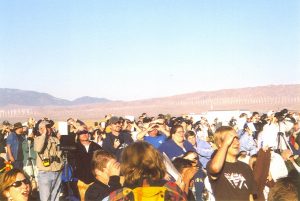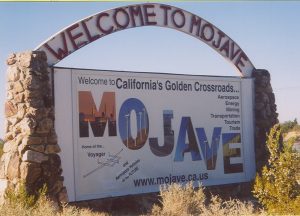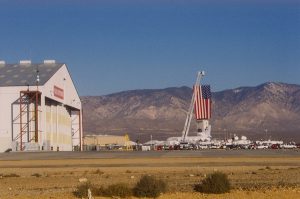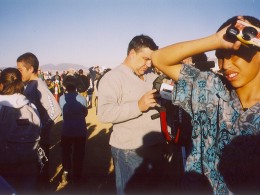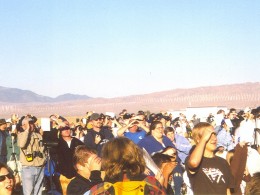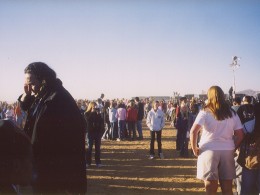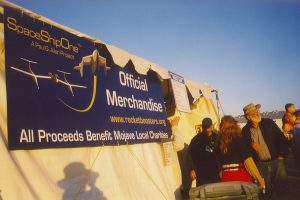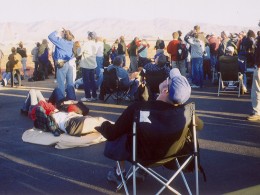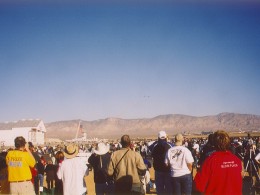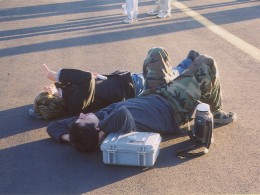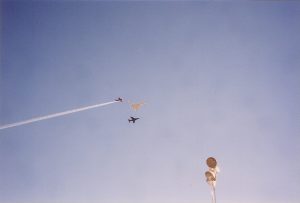What if you could be in Kitty Hawk in 1903? Would you go? How about Paris in 1927 to be there when Lindbergh landed? Or Baikonur in 1961, or the Cape in 1969?
Would you go if you had to get up at 2:30 AM?
That’s what I’d been asking myself all weekend, when I learned that Burt Rutan and Paul Allen’s Spaceship One would be making the second flight to win the Ansari X Prize of ten million dollars on Monday morning at 7 AM. The Mojave airport is about three hours away from us. With all the traveling we’ve done in the last month we really couldn’t justify spending the money to go there on Sunday and stay overnight, and besides, I wasn’t at all sure we’d be able to get a room. It’s a tiny town and there would be a pretty big crowd. So no matter how I added it up, it was going to be a very, very early morning.
* * *
Maybe I’m exaggerating a little, as some enthusiasts are apt to do. It’s not really Kitty Hawk, it’s not the first man in space or on the moon. It’s just up and down, 100 kilometers. The X-15 did that routinely in the ‘60s, though hardly anybody paid any attention with the Mercury and Gemini programs going on.
But I think it’s a lot more important than a lot of people may realize.
I read an article about it recently, pointing out that, if NASA had been running the first qualifying flight a few days ago, the one where the ship started to spin, SS1 would be grounded right now. There would be a Senate committee and a House committee looking into the matter, as well as 5 NASA committees and who knows who else. It would be highly unlikely to fly again for at least a year, and the whole investigation would cost a lot more than the entire development cost of SS1, which is estimated at between 20 and 30 million of Paul Allen’s dollars.
With Rutan’s team it was different. They sat down together, discussed it, identified the problem—which really wasn’t a problem, just a minor error by the pilot—and made their announcement 24 hours later: No problem. We fly on Monday.
This is incredibly important, I think. The future of space exploration will be in private hands. A private group can afford to do something that NASA can never do: take chances. Not that Burt Rutan is ever going to be reckless, he’s not that kind of guy. But he doesn’t have a thousand people looking over his shoulder, either. He’s proved he knows how to get the job done, whatever that job is, and he trusts his own judgement, and that of his other engineers. They can move. NASA can’t. He is almost reclusive, he only calls press conferences when he has something to say, and when he does, he just says it, without any political bullshit. He can do this because he doesn’t take a dime of government money, and that’s the way he wants it.
* * *
So I wanted to be there when the Prize was won. We talked it over, and Lee agreed, though she wasn’t much happier with that 2:30 AM business than I was.
Monday morning, switch on the coffee machine, pop a couple Aunt Jemima frozen breakfasts into the microwave. Shower. Still, it was 3:30 before we were on the road. Not much to say about the trip. NPR radio stations faded in and out. The sky was getting light as we approached Mojave, enough to see the thousands of windmills lining every hilltop. They were spinning slowly.
We reached the airport, which is huge. You can’t help thinking of it as the airliners’ graveyard; there are hundreds of them, giant birds parked out there baking in the sun. They are actually mothballed, not derelict, waiting for aviation fuel prices to drop and people to start getting back on planes. Good luck.
It was all well-organized. The citizens and police of Mojave had experience of these things, they knew how many space and aviation nuts to expect. We drove up to the first checkpoint and we told we could buy tickets for “preferred parking” there … for $75. Yikes! We passed on that, and headed for the “general parking,” where we were told the cost would be $20. We were stuck in traffic for about 15 minutes, but we parked in a huge, rock-strewn dusty lot at 6:45. Fifteen minutes to go before the scheduled take-off. I congratulated myself on building that extra 30 minutes into our schedule. As I got out of the car and headed for the plastic toilets I heard a huge roar, loud as a 747. It’s not an unexpected sound, given where we were, but I looked up and was just in time to see the White Knight leaving the ground with Spaceship One beneath.
Early! They took off early! The sun was just peeking over the mountains in the east, and the bastard was taking off. My highly accurate watch said it was 6:50 AM. So I accidentally discovered the one drawback to private space flight: they go where they want, when they want. If this was a NASA launch, you could expect delays, postponements, scrubs. The one thing you know would never happen is that it would take off early! No space launch in the history of the world has ever gone off early. Until today.
Okay, okay, so Lee missed a chance for photos of the take-off. We now had an hour to wait until the White Knight got the SS1 up to 50,000 feet. We watched it circling for a while, with various chase planes. It would come in and out of visibility, sometimes leaving a vapor trail, sometimes not. We looked around on the ground.
We were maybe half a mile from the big hangar with the big flag hanging over where the $75 people had parked, and beyond that was where the people with passes were, and the press, and, I assume, in the very center, Paul Allen and Richard Branson. Burt Rutan was in “Mission Control”: basically, a small trailer. There was a no-man’s-land between them and us $20 people, patrolled by sheriffs on ATVs and volunteers. Okay, we get the point. We’re second-class observers.
I soon realized that, if we’d gotten there 10 minutes earlier, we would have been ideally positioned to see the craft taxi past us, stop for engine run-up, and then do its take-off roll right in front of us. Damn. But … according to one volunteer, the ship would be touching down almost right in front of us.
Naturally, the early birds had grabbed all the best spots by the orange plastic crowd barriers. We nosed around and found an area that was roped off with yellow plastic tape, that was for the kids off the couple dozen school buses that had showed up for the launch. But the tape was to keep the kids in, not to keep adults out. Nobody objected to our presence there, where we easily found a spot by the fence where Lee would be able to see. (I can see pretty well in any crowd, over the tops of heads.)
The crowd was in the thousands. There was a snack bar in a trailer, and a tent selling souvenirs. We got in a fairly long line because I wanted a pin I could convert into a refrigerator magnet for our collection, but when we got inside they told us they were sold out. Wish they’d marked the pins off the merchandise list outside. Now I’ll have to buy one online, at The Rocket Boosters.
Being in the kiddie section was very interesting. A lot of them were there to do what kids do on playgrounds everywhere: goof off, wrestle, run around like wild dogs. But listening to them jabbering, I found that a lot of them were very knowledgeable about the whole SS1 program and about space flight in general. Most of these kids hadn’t even been born when Challenger blew up. Space flight is as much a part of their lives as personal computers.
One tall Japanese kid knew a lot more about Paul Allen than he knew about space. Bill Gates, too. I heard him saying something like “If Bill Gates spent $1000 a second, it would take him …” such-and-such million years before he went broke. He’ll go far.
I found that the easiest way to spot the three planes was to watch the crowd. Everybody had a camera or binoculars. Just find out where most of them were looking and you had a pretty good chance of spotting the planes.
At last, with about ten minutes to go, the formation had made a large loop to the north and was coming back toward us, leaving a long vapor trail. Then it started to rise. It seemed to keep rising for a long time … and then there was another trail beside it. Everybody was shouting and pointing.
That second trail headed straight up, and up and up and up …
I had wondered if what we were going to see was going to be worth all the trouble. It would all be happening very far above us. But the sense of speed was breathtaking. Spaceship One was screaming along. I snapped off about a dozen pictures and hoped they came out. The sun was still very low, in our faces. And no picture would really show the amazing sight of actually being there.
Then there was twenty minutes to wait. I found my way to one of the speakers, but they weren’t telling us much. About ten minutes later somebody spotted the SS1, followed by chase planes. One of them started releasing some smoke, either to show us where it all was or in sheer celebration. The trio circled, out to the east, and started coming in. We decided that I’d handle the camera for the landing, since I have a higher vantage point. I started snapping as fast as I could go as SS1 approached, as it touched down almost right in front of us, as it zipped past us … and that was the last we saw of it. It taxied down to where the VIPs were waiting, and if you were watching on television or webcast you got a much better view of all that than we did.
And none of those pictures came out! I don’t know what I did wrong. Maybe I was clicking faster than the camera motor could advance the film, but there it is: We don’t have a single picture of the landing to show you. The best shot we’ve got of SS1 is the one at far left above, taken while the ship was circling for the landing. SS1 is the white triangle at the right of the picture. That’s the last time I’ll handle the camera at a critical moment.
But we saw it touch down. We saw the exact second when the Ansari Prize was won. We were there!
The chase planes came in low, in formation. The White Knight landed, very quietly, nothing like its take-off roar. It looked like a rickety model a second-grader might have made out of soda straws and paper cups. You can always tell a Rutan plane, from the Quickie to the Vari-EZ to the Voyager to the SS1. He threw away the book a long time ago and just asked himself the question: What will work? The answer always looks unusual. I mean, the SS1 burns rubber and nitrous oxide. Laughing gas! The cockpits of the SS1 and the Knight are identical. That means that every time you fly the Knight, you are training for the SS1. How’s that for an elegant solution? You think NASA would ever have thought of something like that? Not in a million years. They have no incentive to save money. They always go the luxury route.
It was worth the trip. Even getting up at 2:30 AM.
* * *
I’m not sure what to think of Richard Branson coming on board, planning to use essentially the same vehicle to take very rich travelers for a $200,000 ride. One thing I know: I won’t be riding on Branson Galactic anytime soon. But he thinks he can take 3000 passengers up in 5 years, and when you examine that, it comes to $600,000,000 in income, which would pay the entire development costs of the SS1 program 24 times over. New vehicles wouldn’t cost anything like the $25M cost of the first one. Operating costs aren’t gigantic. Could he really find that many people willing to pay almost a quarter of a million for a 90-minute ride? I think so. Especially if it becomes fashionable. “Have you been Up, dahling? No? What a pity.”
Anyway, whether Branson’s company works or not, there are now many companies on the verge of doing big things in space, not stunts. If you don’t believe me, take a look at Bigelow Aerospace, where they think they can have inflatable space habitats up in just a few years. And they have hardware to show you, not just drawings, like so many blue-sky projects I’ve heard of over the years. There are private rocket boosters, private spaceports in the offing.
So, even if I never get to travel on a Branson vehicle, and may never make the trip personally (I don’t know if my knees can handle it anymore), I feel sure that some of you reading this will have a very good shot at going into space.
I’ll be with you in spirit.
October 4, 2004
Oceano, California

